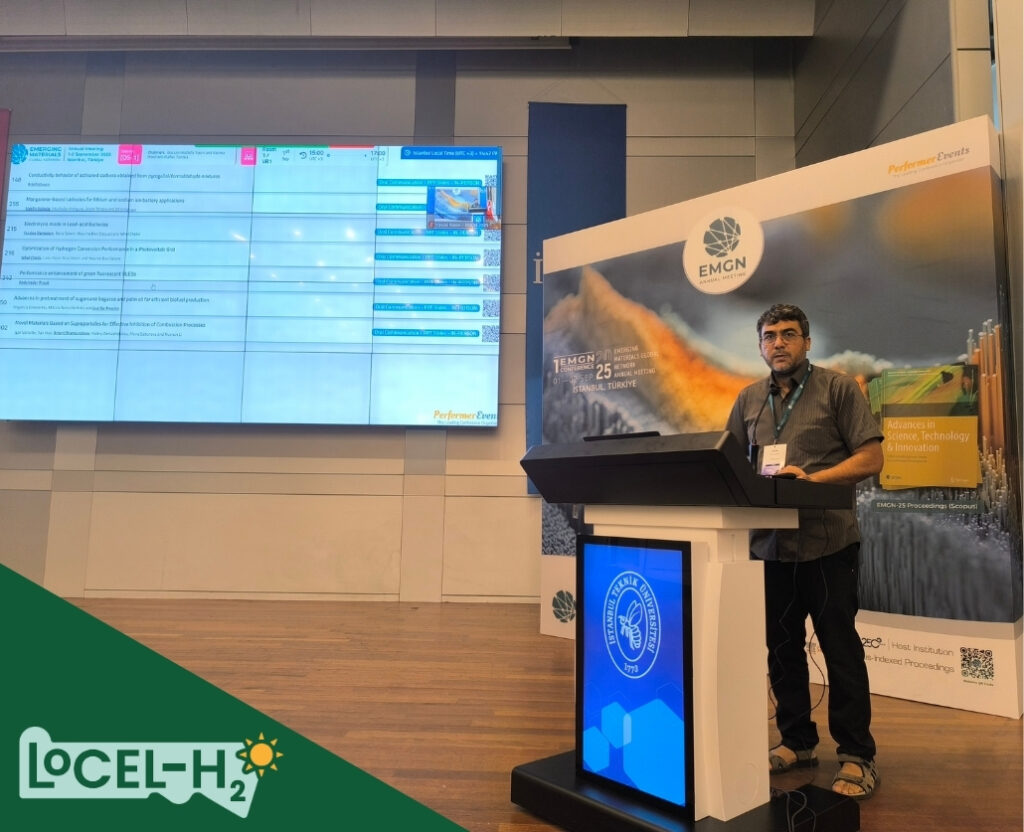University of Gabes Present Two Research Papers based on LoCEL-H2 Project
University of Gabes Present Two Research Papers based on LoCEL-H2 Project
We are delighted to share that colleagues in the LoCEL-H2 Project consortium from the University of Gabes, Tunisia, presented two research papers based on the project at the recent Emerging Materials Global Network Annual Meeting (EMGN-25).


Nihel Chekir and Yassine Bensalem presented their work titled ‘Electrolysis Mode in Lead-acid Batteries’ and ‘Optimisation of Hydrogen Conversion Performance in a Photovoltaic Grid’ to an audience in Istanbul, Turkey.
It is exciting to see the research within the LoCEL-H2 Project continuing to develop and gain recognition in the international community!
Abstracts of the papers:
Electrolysis mode in Lead-acid Batteries
Yassine Bensalem, Dalia Salem, Houcine Ben Daoued, Nihel Chekir*
Abstract: Addressing the dual challenges of efficient energy storage and sustainable hydrogen production is critical to advancing renewable energy systems. This paper presents a com-prehensive simulation of a lead-acid battery to analyse its electrochemical and thermal behaviour during three-mode operation: charge, discharge, and overcharge cycles based on the CIEMAT (Centro de Investigaciones Energéticas, Medioambientales y Tecnológicas) model and analyses its behaviour in the three operational modes. The findings offer valuable insights into optimizing lead-acid battery performance by ensuring short-term energy storage through electricity and long-term energy storage through hydrogen produced during the overcharge mode.
During the charging phase, simulations revealed the progressive increase in SOC and corresponding voltage trends, demonstrating the system’s capacity to efficiently store energy. The dis-charging mode simulations highlight the controlled depletion of SOC and voltage profiles, ensuring a consistent energy output. In overcharging mode, the Battery switches from energy storage to hydrogen production through electrolysis, and the system’s operation shifts towards hydrogen generation.
Optimization of Hydrogen Conversion Performance in a Photovoltaic Grid
Abstract: Proton Exchange Membrane Fuel Cells/Electrolysers (PEMFCs) are considered a promising technology for clean energy production, particularly in transport and stationary applications. This study investigates the optimal operating parameters, such as temperature, pressure, and relative humidity, for the PEM electrolyser and PEMFC. A numerical model was developed using to simulate fuel cell/Electrolyser operation under varying conditions. The proposed system is composed of a PEM electrolyser associated with a hydrogen PEM fuel cell integrated into a photovoltaic grid. The excess electrical energy of the grid is converted into hydrogen, which is stored in a tank. During the night, this hydrogen is reconverted into electricity inside the fuel cell. The proposed Electrolyzer/FC system serves to recover the excess renewable energy in a grid and to ensure the stability and flexibility of this grid. The objective of this paper is to optimize the operational parameters to enhance the total efficiency of the chain to 45%. These findings offer valuable insights for optimiz-ing the performance and improving the efficiency of PEM de-vices in practical applications.
Latest News
Membership enquiry
If you would like to know more about becoming a member of ILA please complete the following form:
Error: Contact form not found.
